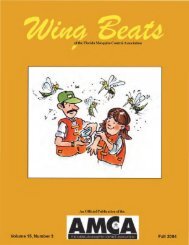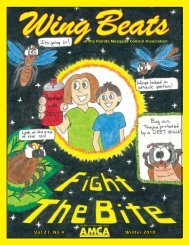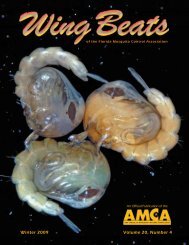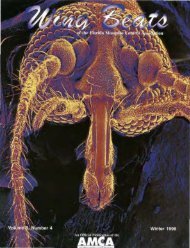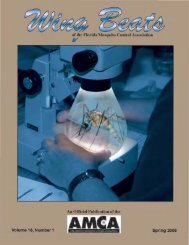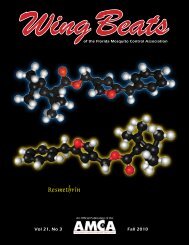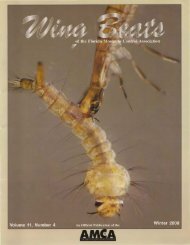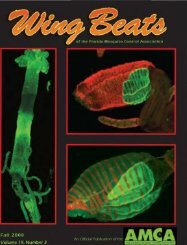41 - Wing Beats - Florida Mosquito Control Association
41 - Wing Beats - Florida Mosquito Control Association
41 - Wing Beats - Florida Mosquito Control Association
Create successful ePaper yourself
Turn your PDF publications into a flip-book with our unique Google optimized e-Paper software.
Why do we do so<br />
much more than just sell<br />
vector control products<br />
and equipment?<br />
Because our<br />
success depends on<br />
your success.<br />
Spring 2008 5
(J CHEMINOVII<br />
FYFANON"ULV<br />
P rotecting children from mosquitoes is a big job. But Fyfanon® ULV, the most trusted mosquito<br />
adulticide in the world, makes that job a lot easier. At 96.5% active ingredient, it's the purest<br />
brand of malathion commercially available. Fyfanon ULV is cost-effective, can be applied by<br />
ground or air, used in rural and urban areas, has low mammalian toxicity and a short residual.<br />
(; CHEM/NOVA<br />
FYFANON@ULV<br />
FYFANON ULV IS AVAILABLE IN 260-GALLON MINI-BULK CONTAINERS, 55-GALLON DRUMS AND 5-GALLON PAILS.<br />
1.800.548.6113 www.cheminova.us.com<br />
(I CHEM/NOVA @2007 CHEMINOVA INC. Always read and follow label directions. FYFANON Is a registered trademark of Cheminova, Inc<br />
For use only by Federal, state, tribal or loG'JI government officials responsible for public health or vector control or by persons certifJecl in the appropriate G'Jtegory or otherwise authorized<br />
by the state or tribal lead pesticide regulatory agency to perform adult mosquito control applications, or by persons under their direct supervision. Not for application to people.
8<br />
first place and share with them<br />
the burden of death inflicted.<br />
WHO has recently changed its<br />
policy governing malaria control<br />
and now endorses use of indoor<br />
residual spraying of insecticides<br />
(IRS) as a primary means of malaria<br />
control, to include use of<br />
DDT. Additionally the US Agency<br />
for lntemational Development has<br />
changed its policy on use of IRS<br />
and DDT funding for countries to<br />
use DDT. Presently DDT use in the<br />
South African Malaria control program<br />
is showing amazing results.<br />
Dramatic reductions in malaria<br />
cases are being recorded and<br />
maintained. Many countries in<br />
Africa have reinstated the use of<br />
indoor spraying with DDT as the<br />
mainstay of their anti-malaria<br />
programs. These enormous<br />
changes in policy should not be<br />
Spring 2008<br />
ignored by the Nigerian Health<br />
Ministry. We expect our country<br />
to show leadership in the use of<br />
DDT in responding to malaria.<br />
As we reposition to achieve the<br />
Millennium development Goals, I<br />
take us back to Mr Sachs' book,<br />
where he says that "there are<br />
certain places on the planet that,<br />
because of various circumstances<br />
- geographical isolation, burden<br />
of disease, climate, or soil - these<br />
countries just can't quite get started.<br />
So it's a matter of helping<br />
them get started, whether to grow<br />
more food or to fight malaria or<br />
to handle recurring droughts.<br />
Then, once they're on the first rung<br />
of the ladder of development,<br />
they'll start c limbing just like the<br />
rest of the world."<br />
I suggest Nigeria is NOT one of<br />
those places. We have what it<br />
takes ... but we need the will. In<br />
2006 the WHO gave the country<br />
$180 million in interest free<br />
loans to fund malaria programs.<br />
None of this was for DDT.<br />
Hopefully this will change.
'Gasofine savings based on conseNatlve estimate of r 20 hours usage per year at $3.00/US Garron<br />
CURTIS DYNA-FOG:td.<br />
For more information:<br />
317.896.2561 www.dynafog.com<br />
®Copyright 2008 Curtis Oyna-Fog, Ltd. AU Rights Reserved
muddy water covered 10,000<br />
square miles, and 31 lives were<br />
lost . In the wake of the July<br />
flooding, affected communities<br />
urgently sought Federal support<br />
for mosquito contro l activities.<br />
Because Georgia agencies had<br />
no means of assessing the need<br />
for mosquito control, the US Public<br />
Health SeNice (PHS) provided<br />
vector control experts to evaluate<br />
the mosquito populations in<br />
affected areas. Although mosqutto<br />
populations had increased,<br />
no significant increases in<br />
mosquito-borne diseases were<br />
detected.<br />
The PHS decided not to initiate<br />
widespread spraying projects,<br />
despite an increase in nuisance<br />
mosquitoes, reflecting concern<br />
for larger environmental issues<br />
such as the effect of spraying<br />
on honeybee businesses and<br />
fish farms in the flooded area.<br />
Eventually, limited spraying for<br />
nuisance mosquitoes was carried<br />
out by the state in several<br />
communities. This experience<br />
demonstrated the need for careful<br />
evaluation of the effect of<br />
specific d isaster response activities<br />
on the community as a<br />
whole.<br />
In "Lessons from the Georgia<br />
Floods" in the Nov/Dec 1995<br />
Public Health Reports, two major<br />
points were made regard ing<br />
vector control. First, there was<br />
no capacity tor emergency<br />
mosquito surveillance and no<br />
awareness of mosquito control<br />
resources within Georgia. Second,<br />
early planning to deal with<br />
environmental concerns would<br />
have minimized non-target impacts<br />
while allowing the control<br />
needed to deal with the intense<br />
nuisance mosquito problem.<br />
In 2005, the Georgia Department<br />
of Human Resources, Division of<br />
Public Health, using funds provided<br />
through a cooperative<br />
agreement with the Centers for<br />
Disease <strong>Control</strong> and Prevention,<br />
purchased a 16-foot 2,486-lb<br />
trailer and equipment to support<br />
surveillance of vector species<br />
and nuisance mosquitoes. The<br />
objective: to determine the<br />
scope of the public healthrelated<br />
mosquito problem, both<br />
vector species and the nuisance<br />
problem. This is important, as<br />
nuisance species can become<br />
a public health issue when<br />
numbers are high enough that<br />
normal daily life is not comfortably<br />
possible. Project priorities<br />
were defined as: immediate<br />
on-site response, contact local<br />
authorities, contact control<br />
agencies, collect data, pool<br />
mosquitoes and send for testing,<br />
provide data to CDC, and provide<br />
control.<br />
I wish I could take credit for<br />
the idea to put together an<br />
emergency mosquito control<br />
response plan for Georgia, comp<br />
lete with surveillance trailer,<br />
but, I can't. The idea that a plan<br />
would be a good thing came<br />
from conversations with many of<br />
my colleagues who have been<br />
through hurricanes and t heir<br />
associated mosquito problems<br />
and have worked hard to prepare<br />
for the next event. The idea<br />
for the trailer came from Dr Bob<br />
Wirtz from the CDC. He wasn't<br />
able to find funding to get a surveillance<br />
trailer for the CDC in<br />
Georgia, so I offered to ask the<br />
Division of Public Health to consider<br />
the need. The timing was<br />
perfect, as this request was<br />
made just after the 'Year of Hurricanes'<br />
in <strong>Florida</strong> and Emergency<br />
Management was looking<br />
into ways in which to p repare<br />
for the possibil ity of a similar<br />
event in Georgia.<br />
Because the trailer was custommade,<br />
it was possible to design<br />
it in such a way that it could<br />
not only be used to bring equipment<br />
to an area but could also<br />
be used as an on-site office.<br />
Equipment purchased for the<br />
trailer include a generator, backpack<br />
spray equipment, both<br />
gravid and CDC light traps with<br />
extra nets and batteries, battery<br />
chargers, IaNoe collecting equipment<br />
a backpack aspirator, dry<br />
ice containers, microscopes and<br />
lights, and supplies needed to<br />
sort, ID, and pool mosquitoes<br />
while maintaining a cold chain.<br />
Additional equipment is needed,<br />
but for now the funding source<br />
has run dry.<br />
Purchasing a trailer and equipment<br />
is just the first step towards<br />
creating an emergency vector<br />
control plan. A vector control<br />
plan is developed as a means<br />
to: 1) c learly identify that a<br />
health and safety issue exists<br />
based on specific c riteria developed<br />
in consultation with<br />
specialists from the CDC; 2)<br />
clearly establish a cut-off date<br />
Spring 2008 11
12<br />
for such funding based on information<br />
from CDC; and 3) establish<br />
a process for requesting<br />
reimbursement of eligible costs<br />
when a water-related disaster<br />
occurs. Our first step in this process<br />
was to develop a protocol<br />
for using the emergency mosquito<br />
surveillance trailer.<br />
Spring 2008<br />
Nothing is done in government<br />
without protocols. The protocol<br />
for the use of this trailer, which is<br />
still in draft form, was modeled<br />
after protocols for the loaning of<br />
equipment during large-scale<br />
forest fires and on the Georgia<br />
County Board of Commissioners<br />
Emergency and Disaster Mutual<br />
Aid Agreement. This trailer, as the<br />
protocol is currently written, is<br />
available for emergency mosquito<br />
surveillance as well as for training<br />
and educational purposes.<br />
It is available to states outside of<br />
Georgia as long as they have<br />
a mutual aid agreement with<br />
Georgia. Several issues are cur-
Modern droplet sizing uses laser<br />
technology, but the instrumentation<br />
is not portable so it is used<br />
primarily in the laboratory or workshop.<br />
Field calibrations are typically<br />
conducted via the waved<br />
slide technique. Another technique<br />
not quite as widespread is<br />
a hot wire anemometer developed<br />
by the US military and commercialized<br />
by KLD Laboratories<br />
as the DC-III. These two field measurement<br />
devices were compared<br />
byJR Brown eta/. in 1993. The<br />
comparison showed that there<br />
was a high degree of correlation<br />
between the two, with the slide<br />
wave selective for larger drops<br />
and the DC-III selective for smaller<br />
drops.<br />
A comparison has been done between<br />
the DC-III and a Malvern<br />
2600 laser light diffraction system<br />
(Matthews and White 2002) which<br />
provides further insight into precision<br />
between laboratory and field<br />
analysis methodologies.<br />
A Spraytec (Moton) Starlet electrically<br />
operated cold fogger providing<br />
32 m 3 lh a ir at 0.34 bar<br />
pressure was used with or without<br />
a No. 74 nozzle restrictor. Samples<br />
were taken at 75 em from the nozzle<br />
where air velocity was about<br />
5 m/s. Other nozzles were used to<br />
obtain sprays with larger droplets.<br />
The results showed that the DC-III,<br />
which has two settings, (oil and<br />
water), gave the best agreement<br />
with the oil setting.<br />
For droplets below 100 11m, the<br />
DC-III and the Malvern 2600 p rovided<br />
similar results. The system<br />
of sampling droplets by each<br />
method is different, so the results<br />
will never be exactly the same,<br />
due to the inherent variability of<br />
sampling methodologies. The<br />
results from this comparison, however,<br />
show that the hot wire system<br />
Figure 3: The droplet size distribution<br />
output is displayed on<br />
a laptop-compui:e'r sc'1'een·. -<br />
Figure 4: The DC-III portable<br />
,droplet counter.<br />
Figure 5: The DC-III probes<br />
are·stored.in a special'.box.<br />
provides an appropriate portable<br />
tool for checking the droplet spectrum<br />
obtained with cold foggers.<br />
It should be stressed, that when<br />
using the equipment, great care<br />
is needed in handling the probe<br />
to avoid breakage; the sensor uses<br />
a 51lm diameter platinum wire.<br />
Secondly, the sprayer needs to be<br />
operated, prior to sampling, for<br />
a short period to remove loose,<br />
hard particles that can break the<br />
sensor. An extension pole or stand<br />
can be used to place the probe in<br />
the spray and eliminate the need<br />
for the user to hold the probe.<br />
The sensor has to be carefully<br />
cleaned after each measurement<br />
according to the manufacturer's<br />
instructions (e.g. a 50% acetone I<br />
50% xylene solution and rinsed<br />
with distilled water) and re-calibrated<br />
by the manufacturer once a<br />
year. The probe must be handled<br />
very gently without touching the<br />
wire ring or sensing wire, and must<br />
be stored and transported in its<br />
original packing material. The air<br />
stream should be tested prior to<br />
sampling, as the probe requires<br />
an air flow of 5 - 7 mls.<br />
PROCEDURE FOR CHECKING<br />
DROPLET SIZE FROM A COLD<br />
FOGGER<br />
1. Set up the DC-III and laptop<br />
computer loaded with DC-III software<br />
and connect probe as indicated<br />
in manual.<br />
2. On computer screen set the<br />
maximum sampling time (e.g.<br />
30 seconds) and I or maximum<br />
number of droplets to be counted<br />
(e.g. 1 000) and the type of liquid<br />
being applied through the cold<br />
fogger. For water-based products,<br />
use the oil setting.<br />
3. Probe is held away from cold<br />
fogger nozzle so that air velocity at<br />
Spring 2008 15
the probe is 5-7 m/s and probe is<br />
perpendicular to the spray nozzle<br />
and centered in the spray.<br />
4. Take replicate readings.<br />
Recommended probe distances<br />
are based on ULV manufacturer:<br />
REFEREN CES<br />
JR Brown, JC Dukes, EJ Beidler,<br />
V Chew and J Ruff (1993) A comparison<br />
of Teflon slides and the<br />
Army Insecticide Measuring System<br />
for sampling aerosol clouds.<br />
Journal of the American <strong>Mosquito</strong><br />
<strong>Control</strong> <strong>Association</strong> 9(4):32-35.<br />
MANUFACTURER DISTANCE<br />
LECO 4 to 6 feet<br />
GA Matthews and AWC White<br />
(2002) A comparison of droplet<br />
sizing with hot-wire and laser light<br />
BEECOMIST 6 in to 1 ft diffraction techniques. Aspects of<br />
Applied Biology 66:451-456.<br />
LONDON FOG 6 feet<br />
Toln"l W. Hock<br />
- C 0 j J" A N Y<br />
18<br />
New Product Announcement<br />
FROMMER U PDRAFT GRAVID TRAP<br />
This new trap (Model 1719) has a collection chamber below the aspirator and<br />
rainshield so that the specimens do not go through the fan. Trap is supplied with<br />
two collection chambers and black media pan. See web for additional details.<br />
Spring 2008<br />
PO Box 12852, Gainesville, FL 32604<br />
(352) 378-3209 voice (352) 372-1838 fax<br />
]WHock@johnWHock.com www.]ohnWHockCo.com
Surveillance<br />
Pool inspections, lab 10, virus<br />
detection, traps,<br />
mapping<br />
Management<br />
Track employee time and<br />
productivity, regulatory reports,<br />
analysis, maps, graphs<br />
Lorvociding<br />
Catch basin treatments<br />
VCMS<br />
Relational Database<br />
Service Colts<br />
Receive service requests, plan<br />
and dispatch<br />
Ground ULV Treatments<br />
Data Master II ULV data capture,<br />
complete log of application time,<br />
GPS location, product, rate and<br />
volume<br />
Aerial ULVtreotments<br />
FlightMaster aerial application<br />
guidance system
24<br />
could be worked out.<br />
NES, based in Amherst, MA, provides<br />
erosion control, sediment<br />
control, vegetated substrates and<br />
customized materials delivery to<br />
their customers using the newest<br />
and most efficient technologies<br />
available to them; see Figure 4.<br />
At the request of CMMCP<br />
Wetland Project Coordinator<br />
Amanda Hope, Ed Severance<br />
from NES came out to the project<br />
area in early 2007 and gave<br />
us a site evaluation and a cost<br />
proposal. As a state agency,<br />
CMMCP does not usually subcontract<br />
any of our seNices, but<br />
this type of program was new<br />
for us and the CMMCP Commission<br />
voted to cost share this<br />
project With homeowner as a pilot<br />
program, in the hopes CMMCP<br />
personnel might be able to do<br />
similar work like this in the future.<br />
NES required two days to do<br />
this work, and in early May the<br />
weather forecast for the next<br />
few days would be perfect.<br />
The compost to be used was<br />
made from recycled organic<br />
materials and completely inert,<br />
free of unwanted seeds and was<br />
guaranteed against invasive<br />
weed intrusion. The pneumatic,<br />
injection system used by NES had<br />
a very low impact on the area,<br />
since the injection operation<br />
was controlled using a remote<br />
system, and the only equipment<br />
necessary for installation was a<br />
technician carrying the hose.<br />
The truck that transported the<br />
compost was specially designed,<br />
and had a moving floor that<br />
carried the compost (or other<br />
material, such as mulch stone)<br />
into an auger system that was<br />
then forced into the hose using<br />
high pressure air; see Figure 5.<br />
Spring 2008
26 Spring 2008<br />
This truck could be refilled during<br />
the project to allow constant<br />
operation, and was parked up<br />
to several hundred feet from the<br />
restoration site.<br />
The first order of business was to<br />
create a stable platform for the<br />
compost socks. A layer of gravel<br />
was blown into the streambank;<br />
see Figure 6.<br />
After the gravel was leveled,<br />
wooden stakes were pounded<br />
into the embankment to further<br />
anchor the compost socks; see<br />
Figure 7.<br />
A layer of geogrid was placed<br />
on the streambank; see Figure<br />
8. Then the first sock was filled<br />
with the gravel m ixture; see<br />
Figure 9.
28 Spring 2008<br />
The remainder of the socks were<br />
then filled with the compost mixture,<br />
and the top layers would<br />
also have grass seed mixed in.<br />
Filling the socks required the sock<br />
to be placed over the spray hose,<br />
using an adapter at the bottom<br />
of the hose to stretch out the sock<br />
to the correct diameter of about<br />
twelve inches. Then a knot was<br />
tied at the end of the sock. As<br />
the truck delivered the compost<br />
to the sock, the hose was pulled<br />
back; see Figure 10.<br />
Once the first sock was in place,<br />
it was flattened slightly, and the<br />
geogrid was pulled up over the<br />
sock and anchored in the streambank<br />
with large wire staples.<br />
The remainder of the socks, now<br />
filled with compost, could be<br />
placed over this foundation, wtth<br />
a slight taper to the back. As<br />
each new sock was placed, compost<br />
was used as a backfill to<br />
create a flat, stable surface for<br />
the next sock; see Figure 11.<br />
After two layers, one side of the<br />
geogrid was wrapped around<br />
the socks, and the final sock<br />
would have the top of the geogrid<br />
wrapped over it and secured<br />
with the wire staples; see<br />
Figure 12.<br />
A compost/seed mixture used<br />
in the final socks was sprayed<br />
on top to blend in the repair with<br />
the existing surface.<br />
One side of the streambank required<br />
3 full socks, with another<br />
one running half way down; the<br />
total height was about four feet.<br />
The other side required two full<br />
socks, with one running about<br />
three-quarters the distance, for<br />
a total height about 2 and a<br />
half feet; see Figure 13.
HISTORY agricultural, medical and veter- tomology staff of CMAVE coninary<br />
importance with the goal sists of 15 permanent scientists,<br />
During World War II, the United of achieving control of pest 6 postdoctoral and/or visiting<br />
States Department of Agriculture species through environmentally scientists, and approximately 50<br />
(USDA) cooperated with the US compatible approaches. CMAVE technical and support person-<br />
Department of Defense to es- consists of four Research Units: nel. The laboratory facility is<br />
tablish a research laboratory in Behavior and Biocontrol, Chem- modern and well equipped and<br />
Orlando, FL. The mission of the istry, Imported Fire Ants and comprises approximately 60,000<br />
laboratory was to develop tech- Household Insects, and <strong>Mosquito</strong> square feet of space.<br />
nologies for the protection of and Fly.<br />
military personnel against insect STAFF<br />
vectors of disease. In 1951, the The mosquito-related mission<br />
laboratory was named the In- of the laboratory is to develop <strong>Mosquito</strong>-related research at the<br />
sects Affecting Man and Animals novel technologies for detection laboratory is undertaken by ten<br />
Research Laboratory. In 1961 , the and population monitoring, permanent, full-time research<br />
Secretaries of Defense and Agri- repellents for the protection of scientists, two full-time support<br />
culture signed a memorandum humans and animals from biting scientists, and four temporary<br />
of understanding to continue the and filth-breeding flies, and ef- postdoctoral scientists.<br />
researc h program under USDA fective chemical, biological, and<br />
funding. In 1963, the lab moved genetic control technologies, as BUDGET<br />
into new federal facilities located well as integrated management<br />
on the campus of the University strategies for insects and arthro- The a llocation of base funding<br />
of <strong>Florida</strong> in Gainesville. The lab- pods of medical and veterinary is defined by the numbers of<br />
oratory's name was changed to importance. The m ission is in permanent, full-time research<br />
Medical and Veterinary Entomol- support of a wide range of stake- scientist positions. At present,<br />
ogy Research Laboratory in 1990 holders, including the Depart- approximately $3,700,000 per<br />
and Center for Medical, Agricul- ments of Agriculture, Health and year is committed to research<br />
tural, and Veterinary Entomology Human Services, Homeland involving mosquitoes. Base funds<br />
(CMAVE) in 1996. Annual base Security, and Defense, livestock are received via the agriculture<br />
funding for the Center exceeds commodity groups, farmers, appropriation approved yearly<br />
$13 million at present. individuals, and companion ani- by the US Congress. Current<br />
mals. The work often provides total extramural funding in sup-<br />
MISSION information that will not only port of mosquito research is more<br />
protect these interests in the than $1,500,000 (from Depart-<br />
The mission of CMAVE is to con- United States, but also overseas. ment of Defense, and industry<br />
duct research on insects of The medical and veterinary en- sources).<br />
"HJin9 'Eeat4- Spring 2008 31
You are invited to submit a title for a paper to be presented at the 2008 80th Annual Fall Meeting of the <strong>Florida</strong><br />
<strong>Mosquito</strong> <strong>Control</strong> <strong>Association</strong>, to be held at the Bay Point Resort Marriott, 4200 Marriott Drive, Bay Point, FL from<br />
November 16-19, 2008. Go to the FMCA website http·UWWVY' florjdamosgujto ors and click the Fall meeting link<br />
for the Call for Papers form. Type the title, author(s), organization(s), and address(es) exactly the way they are to<br />
appear on the program. If more than one author is listed, place an asterisk after the name of the author who is to<br />
present the paper. Send this form to Dennis Moore, Pasco County <strong>Mosquito</strong> <strong>Control</strong> District, 2308 Marathon Road,<br />
Odessa, FL, 33556; e-mail: dmoore@pascomosgujto.ors· telephone: 727.376.4568; fax: 727.376.4704. Please<br />
submit your paper as soon as possible so there is time to plan and organize the program.<br />
NORTHEASTERN MOSQUITO CONTROL ASSOCIATION, INC.<br />
32 Spring 2008<br />
The 54th Annual NMCA Meeting will be held a t the Marriott Providence<br />
Downtown Hotel in Providence, Rl from December 8-1 0, 2008. Room cost for<br />
NMCA will be $1 34 per night (plus tax) - please specify the "Northeastern<br />
<strong>Mosquito</strong> <strong>Control</strong> <strong>Association</strong> Annual Meeting" when you book your room. This<br />
special rate is only effective until Nov. 17, 2008, so please book soon. Please<br />
check our website at www.nmca.org for more information.
RESEARCH OVERVIEW AND<br />
MAJOR CONTRIBUTIONS<br />
CMAVE accomplishments derive<br />
from multi-d iscipli nary team<br />
research and a wide range of<br />
cooperative efforts. Scientists<br />
interact with colleagues and with<br />
animal and public health agencies<br />
and organizations world <br />
wide. Cooperators include the<br />
US Department of Defense, the<br />
World Health Organization, the<br />
Food and Agriculture Organization,<br />
the International Atomic<br />
Energy Agency, the Animal and<br />
Plant Health Inspection Service,<br />
the Centers for Disease <strong>Control</strong><br />
and Prevention, the Food and<br />
Drug Administration, the Environmental<br />
Protection Agency, the<br />
Tennessee Valley Authority, various<br />
universities, local and state<br />
mosquito control programs, sister<br />
ARS laboratories, and industry.<br />
CMAVE has an outstand ing<br />
record of chemical control research<br />
accomplishments.<br />
Research accomplishments of<br />
the scientists concerned with<br />
mosquito research are documented<br />
in approximately 2,500<br />
publications in scientific journals,<br />
conference proceedings, books,<br />
book chapters, handbooks, and<br />
patents.<br />
Major research accomplishments<br />
related to biodegradable pesticides<br />
and personal protection<br />
chemicals include:<br />
• The development of DEET, the<br />
principal active ingredient in<br />
most insect repellents<br />
• The development of the ultra<br />
low volume (ULV) method of insecticide<br />
application for use in<br />
mosquito control<br />
• The development of a clothing<br />
treatment for personal protection<br />
against biting arthropods<br />
Major research accompli sh <br />
ments related to the Biologically<br />
Based Research Program included<br />
developing new biologically<br />
based control strategies for mosquitoes,<br />
house flies and stable<br />
flies. Development of new biological<br />
pesticides and/or control<br />
strategies for vector and pest flies<br />
becomes increasingly important<br />
as human populations grow and<br />
new and exotic disease agents<br />
appear. Alternative control methods<br />
are also needed to combat<br />
high levels of insecticide resistance<br />
in flies that affect animal<br />
production and well being. Such<br />
strategies can help prevent contamination<br />
of the environment<br />
with chemical pesticides that<br />
threaten man and contribute to<br />
a decline in biodiversity.<br />
Examples of new technologies<br />
under development by unit scientists<br />
are:<br />
• Discovery of a new baculavirus<br />
to combat mosquito larvae<br />
in agricultural wastewater<br />
• Development of a protozoan<br />
parasite for control of the "yellow<br />
fever" mosquito, Aedes aegypti<br />
• Development of a new nematode<br />
parasite for mosquito<br />
control<br />
• Discovery of a new parasitic<br />
wasp for control of house flies<br />
and stable flies<br />
• Improvement of the quality of<br />
commercially produced wasps<br />
for fly control<br />
• Development of new traps<br />
to prevent fly immigration into<br />
neighborhoods around farms<br />
• Discovery of chemicals that<br />
cloak humans (make them "invisible")<br />
from mosquito detection<br />
• Development, evaluation and<br />
validation of the biological efficacy<br />
of permethrin-treated USMC<br />
uniforms<br />
Major research accomplishments<br />
of the Surveillance and Ecology<br />
of <strong>Mosquito</strong>, Biting and Filth<br />
Breeding Insects Program are<br />
directed at meeting public and<br />
animal health and military needs<br />
for low-cost, attractant-based<br />
detection systems that determine<br />
the presence and abundance of<br />
nuisance flies and vectors, and<br />
for the development of faster,<br />
less expensive, more specific<br />
and sensitive methods to detect<br />
vectors that may be carrying<br />
endemic or exotic animal or<br />
human pathogens. There is a<br />
critical need to develop a GISbased<br />
system that integrates<br />
these detection methods with<br />
knowledge of the target insect's<br />
biology and environmental factors<br />
for accurate d isease risk<br />
assessment.<br />
Examples of new technologies<br />
under development by unit scientists<br />
are:<br />
• Discovery of new attractants<br />
for house flies, Aedes aegypti,<br />
and mosquitoes that transmit<br />
malaria.<br />
• Discovery of environmental<br />
factors that attract or repel mosquitoes<br />
during oviposition.<br />
• Elucidation of dispersal patterns,<br />
breeding habits and host<br />
attractions of horn fl ies, house<br />
flies, stable flies, and mosquitoes.<br />
• Development of marking systems<br />
to study dispersal patterns<br />
Spring 2008 33
34<br />
of mosquitoes.<br />
• Development of a new generation<br />
of C0 2 and/or heat producing<br />
mosquito traps for improved<br />
surveillance and population management<br />
of selected mosquito<br />
species.<br />
• Identification of octenol as an<br />
important mosquito attractant<br />
and cooperation with private industry<br />
to develop readily available<br />
lures for mosquito surveillance<br />
programs.<br />
• Understanding the role of<br />
species biology and population<br />
genetics in the transmission of<br />
arboviruses.<br />
• Development of speciesspecific<br />
traps that are lightweight,<br />
inexpensive, low maintenance,<br />
and which are surrogates for individual<br />
human or livestock bait.<br />
• Identification and synthesis of<br />
host specific and oviposition<br />
attractants and adapt for use<br />
in traps or bait stations.<br />
• Design and model testing of<br />
a geographic information system<br />
(GIS) technology and remote<br />
sensing to predict the ideal placement<br />
of traps for vector and fly<br />
surveillance, and assess risk of<br />
disease transmission.<br />
• Investigation of the neural and<br />
sensory ultrastructure of ticks and<br />
Diptera.<br />
• Development of measurements<br />
of electrophysiological<br />
activation for use in selecting<br />
vector attractants and repellents.<br />
The Deployed War-Fighter Protection<br />
(DWFP) Program is a Department<br />
of Defense-sponsored<br />
research program administered<br />
Spring 2008<br />
by the Armed Forces Pest Management<br />
Board (AFPMB). It is<br />
tasked with the development<br />
and testing of management<br />
tools for pest and vector species<br />
that transmit diseases to the<br />
deployed war-fighters. New and<br />
improved materials and methods<br />
for pesticide delivery are needed<br />
by the armed forces to prevent<br />
diseases that threaten deployed<br />
troops. Research at CMAVE involves<br />
the discovery, evaluation,<br />
development and optimization<br />
of: l) new pesticides effective<br />
against mosquitoes and flies;<br />
2) new personal protection products<br />
effective in p reventing<br />
mosquito and fly bites; and 3)<br />
new application and personal<br />
protection methodologies and<br />
strategies.<br />
Recent accomplishments include:<br />
• Re-evaluation of old chemistries<br />
for their effect on mosquitoes.<br />
• Development of new pesticides<br />
using molecular biology<br />
techniques to pinpoint target<br />
physiological process in insects.<br />
• Development of spatial repellent<br />
delivery field kits to be used<br />
by war-fighters.<br />
• Testing of spatial repellents for<br />
use in military tents.<br />
• Development of barrier-spray<br />
strategies for use by deployed<br />
troops.<br />
• Selection of more efficient fly<br />
traps for use in arid conditions<br />
where US troops are deployed.<br />
Future research is being directed<br />
at the following:<br />
• The discovery and development<br />
of new biological, behaviorat<br />
physiological, genetic, and<br />
chemical regulating mechanisms<br />
that can be used for mosquito<br />
control.<br />
• The validation of recently discovered<br />
biological, chemical,<br />
and genetic mosquito control<br />
technologies in large-scale, areawide<br />
management programs<br />
targeted at natural populations<br />
of mosquitoes.<br />
• Scientific, economic, and sociologically<br />
sound analyses of<br />
the costs of mosquito control in<br />
relation to benefits accruing to<br />
the public (improved quality of<br />
life) and animal/ public health<br />
(disease vector abatement)<br />
worldwide.<br />
Kenneth J linthicum<br />
CMAVE Director<br />
Gary G Clark<br />
Research Leader<br />
<strong>Mosquito</strong> & Fly Research Unit<br />
Sandra Allan<br />
Donald R Barnard<br />
James J Becnel<br />
Ulrich R Bernier<br />
David A Carlson<br />
Chris J Geden<br />
Jerome A Hogsette<br />
Daniel L Kline<br />
Center for Medical, Agricultural<br />
& Veterinary Entomology<br />
Agricultural Research Service<br />
US Department of Agriculture<br />
1600 SW 23rd Drive<br />
Gainesville, FL 32608<br />
352-374-5901
36<br />
Spring 2008 <strong>Wing</strong> <strong>Beats</strong>
FROM WHERE I SIT.. ..<br />
In anticipation of the challenges<br />
an increasingly aggressive antipesticide<br />
agenda may present<br />
this year to vector-borne disease<br />
control, the AMCA Public Relations<br />
Committee reviewed our<br />
strategies for countering (or preempting)<br />
their message. After<br />
considerable reflection, the<br />
committee agreed that the toll<br />
exacted by vector -bome disease<br />
needs a human face in order to<br />
engender greater support for<br />
acceptable control strategies<br />
from constituents. To this end,<br />
Central Life Sciences, with Mark<br />
Newberg as the guiding force,<br />
has developed a 30-second<br />
Public Service Announcement<br />
(PSA) video entitled "I'm One,"<br />
that places the impact of West<br />
Nile virus in a human perspective,<br />
utilizing actual WNv victims<br />
to dramatize the disease's impact<br />
on their lives. This PSA will<br />
be part of a nationwide public<br />
relations program designed to:<br />
l . Highlight the importance of<br />
prevention and control methodologies<br />
by directing consumers<br />
and media to the AMCA web-site.<br />
2. Educate the public.<br />
3. Rally survivor organizations<br />
with a single, unified message.<br />
The "''m One" program is multifaceted<br />
and consists of the PSA,<br />
revisions of the AMCA consumerfacing<br />
website and Media Toolkit,<br />
formation of a Survivor Support<br />
Council, and a national media<br />
relations outreach initiative. The<br />
audiences we are targeting consist<br />
of consumers, the media,<br />
public health officials and AMCA<br />
members.<br />
At the recent AMCA annual<br />
meeting in Reno, Mark Newberg<br />
explained our marketing strategy<br />
during the plenary session kicking<br />
off the "I'm One" program. In<br />
addition, a booth at the meeting<br />
was manned by professional<br />
marketing personnel from<br />
Fleishman-Hillard International<br />
Communications and provided<br />
information on how to launch<br />
the program and maintain effective<br />
public relations in local<br />
markets. Tool-kit folders, consisting<br />
of media outreach instructions,<br />
PSA DVDs, talking points,<br />
and press release templates<br />
were distributed to attendees<br />
who visited the booth. It was<br />
heartening to see the rapidity<br />
with which the media packets<br />
were snatched up by attendees<br />
eager to augment their PR<br />
arsenals. Although we had determined<br />
that broadcast-quality<br />
DVDs were the most likely format<br />
that television stations would<br />
use, we've recently had reports<br />
of stations that prefer Beta format.<br />
We are currently discussing<br />
whether we will expend the resources<br />
to have the PSA reproduced<br />
in Beta. I'll keep you<br />
posted.<br />
During <strong>Mosquito</strong> Awareness Week<br />
(June 22-28), a concerted effort<br />
will be made to pitch the PSA<br />
to large, strategically-important<br />
media markets throughout the<br />
United States. Fleishman-Hillard<br />
personnel will be doing the<br />
actual pitching in order to maximize<br />
media response. Criteria<br />
for market selection included:<br />
incidence of West Nile virus,<br />
opposition to mosquito abatement,<br />
relevant local-market<br />
media, and existence of key<br />
opinion leaders in the market.<br />
Markets selected were Chicago,<br />
Detroit, Cleveland, Washington<br />
DC/north Virginia, Baltimore,<br />
Atlanta, Los Angeles, San Francisco/Oakland/San<br />
Jose, Portland,<br />
Seattle, and Denver. I would certainly<br />
encourage all of you to<br />
reproduce the PSA locally to the<br />
maximum extent to optimize<br />
its d istribution during <strong>Mosquito</strong><br />
Awareness Week and the various<br />
county festivals during the year.<br />
Alas, it has become increasingly<br />
evident that the Member Toolkit,<br />
as currently configured on the<br />
AMCA website, does not meet<br />
the needs of members accessing<br />
it seeking assistance for their<br />
communications programs. The<br />
Toolkit was meant to provide<br />
templates and fact sheets for<br />
district's various communications<br />
needs. Unfortunately, the website<br />
software did not allow the<br />
user to download individual documents<br />
in order to modify them<br />
for local needs, resulting in a<br />
large (70 Mb) and unwieldy download<br />
containing several different<br />
file formats. In order to make it<br />
more user-friendly, I've prioritized<br />
all of the files and deleted unnecessary<br />
documents. <strong>Association</strong><br />
Headquarters is reconfiguring<br />
Spring 2008 37
38<br />
the AMCA web software to make<br />
the Toolktt files capable of being<br />
individually downloaded, modified<br />
and saved on remote computers.<br />
The end product will<br />
consist of various fact sheets<br />
and/or links to sites with fact<br />
sheets and contact information<br />
(congressional, supportive websites,<br />
etc), instructions on how<br />
to contact media, key messaging,<br />
template op-eds, letters to<br />
the editor, and letters of support<br />
which can be tailored for key<br />
legislative officials.<br />
The AMCA consumer-facing<br />
web-site requires some alterations,<br />
too, to make it more userfriendly<br />
to consumers looking<br />
for information on West Nile virus<br />
contro l. Although the final look<br />
has yet to be determined, we'll<br />
be consolidating WNv issues,<br />
tips on protection and prevention<br />
and the PSA in a large link<br />
on the home page. We'll also<br />
post links to survivor outreach<br />
pages with recent vector-borne<br />
disease news and any upcoming<br />
events involving survivor groups.<br />
The key here is to make information<br />
for the consumer no more<br />
than two keystrokes away from<br />
the website.<br />
Along the same line. we'll attempt<br />
to increase media interest in the<br />
AMCA by clearly highlighting<br />
a media materials section on<br />
the homepage containing fact<br />
sheets and news releases. Here<br />
again, navigability is key - the<br />
easier it is to locate information,<br />
the more the media will use it.<br />
Our goal is to ensure that AMCA<br />
assumes a leading role on WNv<br />
in the m ind of both print and<br />
broadcast media.<br />
There are various survivor groups,<br />
the emotive aspect of whose<br />
message can appeal to groups<br />
Spring 2008<br />
historically susceptible to emotional<br />
appeals. These groups<br />
constitute a resource that we've<br />
begun to utilize as a basis of<br />
support for our operations. Many<br />
of you who have attended our<br />
Washington Legislative Conferences<br />
in the past may remember<br />
Wendy Station and, more<br />
recently, Kimberly King. who<br />
have related their stories to the<br />
attendees. Theirs is a powerful<br />
message that goes far beyond<br />
mere statistics and graphically<br />
portrays the very real suffering of<br />
those who have had loved ones<br />
suffer from vector-borne disease.<br />
There are several legitimate survivor<br />
groups in North America,<br />
but they tend to operate in small,<br />
relatively proprietary sectors. In<br />
order to coalesce and leverage<br />
their messages for optimal effect,<br />
we propose to organize a West<br />
Nile virus I Encephalitis Survivor<br />
Advisory Council. Makeup of the<br />
council would be fully vetted<br />
to ensure legitimacy and maximize<br />
effect. The formation of a<br />
council of survivor groups would<br />
serve to unify local groups at<br />
national level with a single message<br />
in addition to providing a<br />
venue to utilize these groups to<br />
disseminate information to their<br />
constituents and the public at<br />
large.<br />
In light of Dr Lyle Peterson's<br />
personal experience with West<br />
Nile disease, he was my fi rst<br />
choice as a credible participant<br />
and he has graciously agreed<br />
to assist in any way possible.<br />
A great deal of additional discussion<br />
regarding the makeup<br />
and charter of this group needs<br />
to occur in order to ensure its<br />
success over the long term. The<br />
AMCA will keep you posted on<br />
its p rogress.<br />
I'm perfectly aware that the "I'm<br />
One" program and its components<br />
may not meet all member's<br />
needs or expectations at<br />
the outset. Its national scope<br />
necessitated our formulaic approach,<br />
irrespective of regional<br />
peculiarities. Nonetheless, I<br />
believe there is enough flexibility<br />
built into the program that<br />
districts can tailor its message<br />
to their own constituencies. The<br />
fundamental message is that<br />
the experience of mosquitoborne<br />
disease is a very personal<br />
and horrifying one for those<br />
involved. As mosquito control<br />
professionals, we are dedicated<br />
to preventing these diseases<br />
where possible and we need feel<br />
no compunction about doing so.<br />
Dr Richard Pollack of Harvard<br />
once stated (and I'm paraphrasing<br />
here) that we deal in probabilities<br />
of disease, whereas the<br />
anti-pesti cide activists deal in<br />
possibilities of harm. This goes<br />
to the heart of the matter. The<br />
very real suffering of those so<br />
dramatically illustrated in the<br />
"I'm One" PSA should put those<br />
possibilities/probabilities in their<br />
true perspective, for, at its most<br />
elemental. the abeyance of this<br />
suffering is the fundamental<br />
reason we do what we do.<br />
Joseph M Conlon<br />
AMCA Technical Advisor<br />
1 500 Millbrook Court<br />
Orange Park, FL 32003<br />
904-215-3008<br />
amcata bellsouth.net<br />
-------



